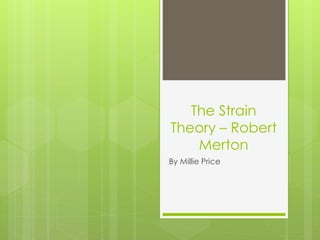
Merton's Strain theory - theory and methods A2 Sociology
- 1. The Strain Theory – Robert Merton By Millie Price
- 2. Robert Merton- Robert K. Merton developed the structural strain theory as an extension of the functionalist perspective on deviance.
- 3. The Strain Theory- Robert Merton (1910-2003) argued that society may be set up in a way that encourages too much deviance. Merton believed that when societal norms, or socially accepted goals place pressure on the individual to conform they force the individual to either work within the structure society has produced, or instead, become members of a deviant subculture in an attempt to achieve those goals. Merton termed this theory Strain Theory
- 4. TYPOLOGY OF DEVIANCE AND EXAMPLES: Merton's main concern was that societies such as the United States do not provide the means (access to education, employment, etc.) to achieve cultural goals (the American Dream). When individual's are faced with a gap between 'what ought to be' and 'what is', that person will feel strained and have a choice between five modes of adaptation. Merton's mode of adaptation
- 5. He used the lifestyle concept of the American dream which places great emphasis on material success. The term “American dream” is used in many ways, but it essentially is an idea that suggests that anyone in the US can succeed through hard work and has the potential to lead a happy, successful life. Many people have expanded upon or refined the definition to include things such as freedom, fulfillment and meaningful relationships. Someone who manages to achieve his or her version of the American dream is often said to be “living the dream.”
- 6. The 5 Modes Of Adaption: Merton outlined five possible ways that members of American society could respond to success goals: 1. Ritualism 2. Retreatism 3. Innovation 4. Rebellion 5. Conformity
- 7. 1. CONFORMISTS Conformists are people who believe in normative means for attaining goals legitimately. They follow the rules of society. An example would be a successful investor or businessman who is economically successful because of their employment or hard work.
- 8. 2. RITUALISTS Ritualists are individuals who stop trying to achieve goals but believe in using legitimate means for attaining goals. (follow rules) For example, Staying in a dead end job.
- 9. 3. INNORVATORS Innovators are those individuals that accept the cultural goals of society but reject the conventional methods of attaining those goals. They Use different ways to achieve those goals (criminal) An example is a stockbroker who engages in illegal insider trading. The cultural goal of wealth is accepted, but nontraditional means of insider trading are used. Drug dealers, thieves, and prostitutes are also examples of innovators.
- 10. 4. RETRETISTS Retreatists are individuals who reject both the cultural goals and the accepted means of attaining those goals. They simply avoid both the goals and means established by society without replacing those norms with their own counter-cultural forces. For example- Severe alcoholics, some homeless people, and hermits are examples of Retreatists.
- 11. 5. REBELS Rebels not only reject both the established cultural goals and the accepted means of attaining those goals But they substitute new goals and new means of attaining those goals to bring about revolutionary change and create a new society. Examples of rebels include the American Nazi party, “skinheads,” and the Ku Klux Klan.
- 12. EVALUTATION Merton shows how normal and deviant behavior can arise from having the same mainstream goals. How does he explain patterns shown in official crime statistics? Most crime is property crime, because American society values material wealth so highly Lower class crime rates are higher, because they have least opportunity to obtain wealth legitimately.
- 13. How does this link to white collar crime? Merton’s strain theory has been developed in an attempt to explain white collar crime. People turn to illegal means to become successful and attain monetary goals. They Experience strain to anomie which weakens the mechanisms of social control. So Corporations may find that legal ways of maintaining or increasing their profits are ineffective. Therefore there is pressure to turn to illegal means - fraud, ignoring health and safety and environmental regulations.